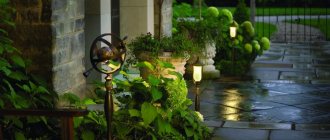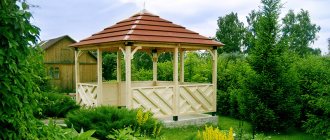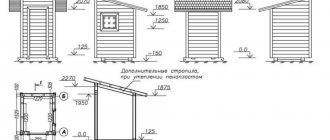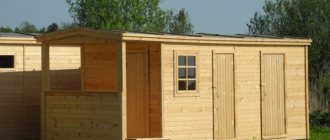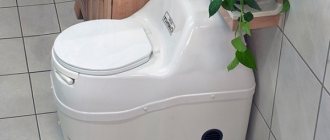A nice fountain for a pond in a country house has long ceased to be a curiosity and is often an integral element of landscape design. The reason for its popularity lies in the life-giving energy of water flows and the high decorative component of the object. The opinion that installing a fountain in a dacha is accessible only to a narrow segment of society due to its high cost is erroneous; the variety of shapes and sizes makes it possible to decorate the site with a budget copy. A self-made fountain can reduce costs when arranging landscape design.
Unity of style in a country house with a fountain
The appearance of modern fountains amazes with the variety of design ideas. Each style of landscape design has its own original solution to the water composition. In addition to the design form and dimensions, materials and additional decorative elements help express the overall design concept.
When thinking about the murmuring streams of water, a picture of landscape design with a traditional fountain invariably appears, where the basis is a sculpture in the form of a mythical or fairy-tale hero, a flower bowl or other figure decorated with relief decor. This solution is suitable for lovers of classical forms who stand for the preservation of traditions or strive for a presentable landscape design.
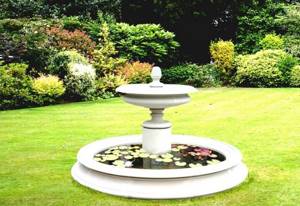
Creative people will appreciate fresher ideas. As an experiment at the dacha, you can install:
- avant-garde pieces made of glass and metal;
- Swiss fountain, which is characterized by a huge height of water jets;
- tornado design, where water flows fall from above;
- A fountain with fog looks original in landscape design;
- an amazing design where water flows over a glass panel or ball.
Ideas for arranging a landscape design with a fountain are inexhaustible. Perhaps your own design will become no less interesting an object than a finished copy. Depending on the planned expenses and the area of the dacha site, the fountain is installed on an artificial pond or in a special bowl.

Manufacturers offer ready-made fountains equipped with compact reservoirs, which are installed directly on the surface. Such products find their place on any hard surface area. This could be a winter garden, a terrace or a patio, it all depends on the landscape design project.
Photos will help you evaluate the variety of solutions for arranging a fountain at your dacha:
Decorating a garden fountain
Traditionally, the fountain outlet is designed in the form of sculptures, designer structures or natural decorations in the form of stones.
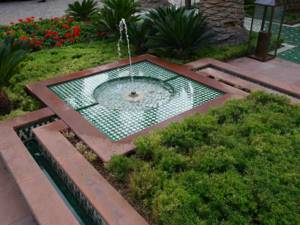
In addition, fountains are often illuminated. Thanks to this, they can be admired even in the dark evening. This is especially important for devices in the seating area. The backlight is usually made of LEDs and is atomically powered by solar panels. This is the safest and most economical option.

Types of fountains
Garden fountains differ not only in appearance. When designing landscape design, it is important to decide in advance on a suitable internal structure.
Stationary
Independent architectural forms, which most often decorate parks and squares, belong to the stationary type of fountains. They usually contain a decorative element that imitates a water source. Numerous streams, a central sculpture or an entire composition look extremely impressive in landscape design.
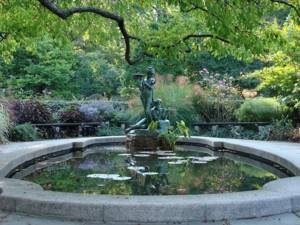
The internal structure of a stationary structure is quite complex in execution. It is better to entrust the arrangement and installation of such a facility to specialists. The high cost and complexity of the process have become the reason for the limited use of stationary fountains in the country. Expensive landscape design is more appropriate in a fashionable country estate with a large area and appropriate furnishings.
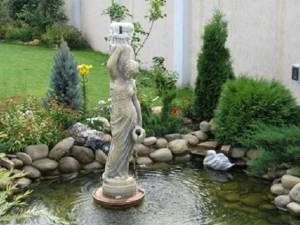
Comment! If you want to become the owner of a stationary fountain, you should pay attention to the modern polymer material polystone, which successfully imitates natural stone.
Sculptures and other objects made of polystone look in landscape design no worse than models made of natural stone. At the same time, they have remarkable advantages:
- the cost is significantly lower;
- light weight;
- ease of installation and further operation;
- absence of rotting and deformation processes;
- stability under the influence of strong pressure of water jets.
Such characteristics are a strong reason to use a fountain based on polymer stone in landscape design. There are many design solutions. A modest area can be decorated with one laconic object; to arrange an impressive area, it is better to use a composition of several objects.
Fountains look stylish and creative in landscape design, where water flows in a continuous stream over the main protruding element. Very often, a spherical shape is used for these purposes. It seems that the source of water is the stone itself. In fact, the flow comes out of a hose located in the center of the figure.
Vivid examples of landscape design with decorative fountains for dachas are presented in the photo below:
Submersible
It is much easier to choose a submersible garden fountain for a summer cottage, which is not an independent landscape unit, but acts as an additional element of the water composition. A harmonious picture is obtained when using a submersible fountain on a pond.
In the process of designing a landscape design, you can choose one of two popular designs, which are conventionally called “key” and “stone”. The name of the fountains speaks for itself. In the first case, the “key” consists of a pipe with a nozzle, which is immersed to the depth of the pond in such a way that the main elements are not visible. After the water pressure is adjusted, an elegant picture of a gushing spring is created on the surface of the pond, indistinguishable from a natural source.

A harmonious landscape design is obtained by using a “stone” fountain, where a hose extending from a pressure pipe passes through a hole in the stone, and a stream of water flows from there. A stone fountain looks especially impressive at the bottom of a transparent pond.
Advice! Colored lighting can enhance the decorative effect of a composition in landscape design.
The construction of the structure is not complicated. To work, you will need a disk with multi-colored glass fragments, a lamp for illumination and a bell in the form of an attachment.
Examples of submersible fountains in the country are shown in the photo:
Fountain with waterfall
Landscaping techniques using water know no boundaries. Submersible fountains create a backdrop for visual contemplation; cascade structures will help you enjoy the murmur of water. Combined structures, where a fountain and a waterfall are combined in one object, will become a worthy element of landscape design.

The principle of operation is not complicated: water, rising up the pipe, forms a stream that falls down a cascade of stones. They can be replaced by other decorative elements arranged in steps.
The following photos will not leave anyone indifferent and will give you the opportunity to enjoy the exquisite picture of landscape design, which includes a waterfall fountain:
Benefits of garden fountains
Garden fountains have a number of technical advantages that many owners have already appreciated.

The main advantages of fountains:
- Creation of a microclimate. On a hot day it will also give you coolness.
- Increased humidity around the fountain.
- Creating a romantic, comfortable atmosphere.
- Low water consumption. Water can circulate in a closed cycle.
- Constantly new decoration. It seems new every day.

Sound effects
When planning the presence of any type of fountain in the landscape design, it is worth paying attention to the sound. The sound of water can be different:
- quiet and loud;
- soft and bubbling;
- sonorous and muffled;
- cheerful and calm.
There are two main factors that influence the character of a fountain's song: the shape and height of the jets. Thin and high-rising jets of water can generate ringing notes. Volumetric and wide flows will complement the landscape design with a deep and calm sound background.
Special nozzles are responsible for the formation of jets. Typically, manufacturers offer 2-3 different types of products in a set. This allows you to diversify not only the visual range, but also expand the sound range of the fountain.
At the birth of the “song of water”, the speed of its flow also matters. The sound can be changed during the operation of the structure by adjustment, which is provided in the equipment set.
The photo is not capable of conveying sound effects, but it can highlight the elegance of landscape design with the presence of a fountain:
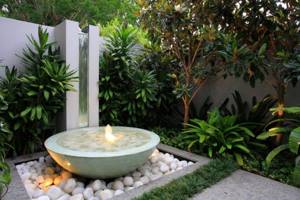
Types of fountains
Garden fountains are divided primarily into two main types:
- Decorative fountains.
- Pond fountains.
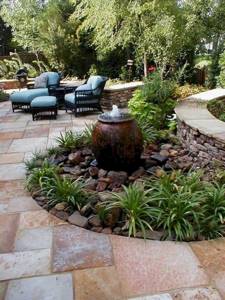
Decorative options are installed separately and have their own bowl. They have an autonomous water supply from the water supply. And of course, they have the most beautiful appearance.
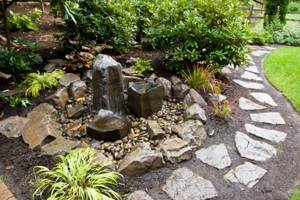
Pond fountains consist mainly of a divider and a pump. In addition to them, you can purchase decorative decorations in the form of a jug, stones or other options.
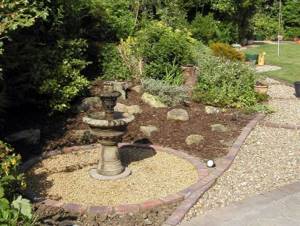
Fountains also come in closed or open cycle. In a closed cycle, the water in the fountain is constantly circulating in a circle. In an open cycle, it is taken from a reservoir and returned to it. However, it is still flow-through.

Energy of water
In addition to its decorative role, the fountain also plays a significant practical role in landscape design. First of all, a design where water is in constant movement humidifies the air most effectively. There is also a more sublime theory that will be appreciated by people who strive for a healthy atmosphere. The bottom line is this:
- With the rapid movement of water, first upward, then falling and splashing, the structure of water molecules changes.
- The atmosphere of landscape design is filled with ions with a negative charge, which scientists call “health vitamins.”
- These particles are the antipodes of positive ions, which have a negative effect on the human body. An atmosphere filled with dust and permeated with radiation from household appliances surrounds us everywhere.
Comment! You can enjoy clean air with negative ions in the mountains and on the sea coast.
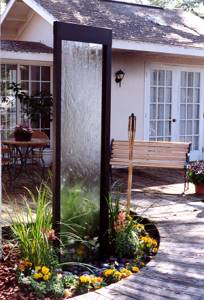
Therefore, landscape design with a fountain is not only a pleasant backdrop for visual enjoyment, but also an affordable source of a healthy atmosphere. Penetrating into the human blood, negative water ions have a stimulating effect on biochemical processes and trigger regenerative functions.

The positive effect of the presence of a fountain in the landscape design can be enhanced by decorative lighting of the structure, which has a greater effect on the psycho-emotional state. This can be static lighting, which fills the pond with a fountain with original shades. The dynamic play of color looks much more interesting, especially when accompanied by music. If desired, both options can be used in landscape design, depending on the mood and the appropriate occasion.
Organic examples of a fountain, which plays a prominent role in landscape design, are shown in the photo:
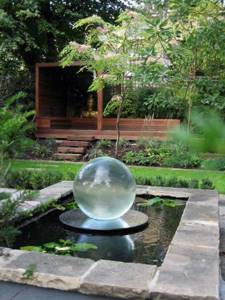
The main stages of arranging a fountain
In order to preserve an attractive landscape design for as long as possible, it is important to choose a convenient location and appropriate equipment for the fountain in your dacha. At the final stage, it would be a good idea to think about the decorative design.
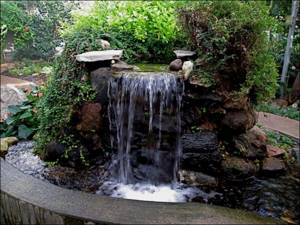
Determining the place
Regardless of the chosen type of fountain, whether it will be located on the dacha pond or stand as a separate object of landscape design, when choosing a location it is worth considering several features:
- The presence near trees and tall bushes is undesirable. Fallen leaves will cause rapid contamination of the water, but even worse when it clogs the pump. The second aspect is that the root system of trees can cause deformation or destruction of the fountain structure.
- When developing a landscape design project, the location of the residential building and outbuildings relative to the fountain on the pond is taken into account. The water source must be located at a sufficient distance from the structures; high humidity can accelerate the deterioration of the façade and affect the indoor microclimate.

- The wind rose of the region also matters. A comfortable stay near the fountain should not be overshadowed by regular drops of splashes reaching vacationers. It is advisable to provide for all the nuances at the initial stage of landscape design planning.
- A completely open space is also not optimal for a pond fountain, especially in hot climates. The constant sun will strongly warm up the water surface and can provoke its flowering. Excessively heated water negatively affects the operation of the pump. The best option is when in the landscape design a place with variable shade and lighting is allocated for the fountain.
Each site has its own characteristics, which the owner of the dacha is aware of, and which should be taken into account when choosing a place in the landscape design for the fountain.

Selection of components
The most significant part of the fountain arrangement process, which deserves a separate publication. Let's look at the main points:
- The easiest way to purchase a bowl for a stationary structure is ready-made, made of composite materials.
- The required pump power and hose diameter depend on the planned jet height. A small fountain with a jet of up to 50 cm is equipped with a pump of 1000 l/h and a hose Ø 1.5 cm. When the pressure increases to 1.5 m, the figures are 3000 l/h and Ø 2.5 cm, respectively.
- The functioning of a fountain in landscape design is unthinkable without cleaning filters.
- The choice of nozzles that form the required thickness and height of the fountain jets, creating an attractive water composition in the landscape design, also deserves attention.
- To make your landscape design sparkle with new colors in the literal sense of the word, you should take care of installing colored lighting.
- Equipment that allows you to regulate individual processes remotely will help improve the operating process.
An organic example of landscape design with a fountain in the photo:
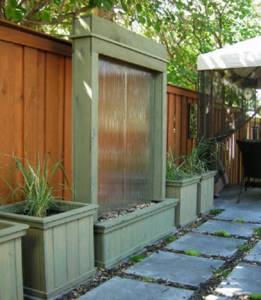
Final decoration
Proper decoration of the fountain will help create a harmonious picture in landscape design. Please pay attention to the following points:
- It is better to choose one or two types of stones around the pond. A lot of variety is not required.
- Plants are selected in accordance with development conditions. They must love water or tolerate high humidity well.
- If you are planning a landscape design with a twist, when fish will swim in the pond, you should ask about their tolerance to the noise of water from the fountain.
Attention! If a bowl made of polymer stone is chosen for the fountain, practically no additional decor is required.
The use of polyuston in the framing of fountains usually presupposes a laconic concept of landscape design, without unnecessary decorative elements. The object is valuable in itself and does not need additional decoration.
Details Types of fountain structures
Type 1
Based on the principle of general architectural design, street fountains can be divided into three main groups. In the first, water plays a dominant role. In the second, sculptures and decoration are of primary importance, and water is of secondary importance. This solution is most typical for ancient and medieval fountains. And finally, in the third group, which includes the majority of fountain structures, the water composition and the architectural part are equivalent and complement each other.
A: Fountain bowl (pool) B: Drain pipe C: Bottom drain with plug D: Supply pipe E: Water drainage hole F: Fountain nozzle G: Underwater light H: Sealed cable entry I: Drain pump J: Return fitting K: Return line L: Debris guard M: Water flow distributor N: Submersible pump O: Electrical supply
Type 2
Flow fountains in most cases imitate the natural movement of water along stone steps. The principle of such a fountain is simple - water flows from a source located at a high level down a more or less long and winding “corridor” and ends up in a lake, pond or pool. Here it is important to accurately size the pump so that there are no problems pumping water from the lower water reservoir and sending it back to the top.
A: Drain pipe B: Submersible pump C: Gate valve D: Check valve E: Overflow-drain fitting F: Safety grill G: Supply pipe H: Overflow tank
Type 3
Often fountain complexes include so-called waterfall fountains, which are a curtain of freely falling water having different widths and heights. When creating a waterfall, it is important to choose the right container so that its size allows you to avoid overflowing water. And the edges of the container should always be clean. Try not to place waterfalls under trees. A properly selected pump is also important.
A: Overflow tank B: Guide plate C: Water flow distributor D: Waterfall edge E: Supply pipe F: Drain pipe G: Overflow-drain fitting H: Check valve I: Valve J: Safety grill K: Submersible pump
Type 4
One of the simplest and most frequently used types of fountains. The fountain's basin is buried in the ground; there is a special recess in the base for the pump and all equipment. The advantages of this fountain are its shallow depth, elegant design, and convenient built-in overflow-drain system. Disadvantages include high costs when installing a pool, fittings and cables. Additional options: underwater lighting, electric control panel, electronic water level control.
A: Sealed cable entry B: Stainless steel container C: Underwater light D: Protective grill E: Fountain nozzle F: Cable protection pipe G: Submersible pump H: Overflow-drain fitting I: Drain pipe J: Fountain basin
Type 5
The next option is the simplest types of fountains with a dry-mounted centrifugal pump. The pool is located on the ground, and the suction and discharge pipes lead to the adjacent basement where the pump is located. The advantages of this system: relatively low costs and low costs due to the elimination of minor comfort devices. There is no need to dismantle the pumps in winter. The disadvantages are the large depth of the pool, and therefore the possibility of an accident. Large costs for cleaning the pool, since there is no drainage system. The technique of the fountain structure itself is partially visible. Additional options: overflow drain fittings, underwater lighting, electrical switching device, electronic water level control.
A: Fountain Pool B: Fountain Nozzle C: Bottom Fitting D: Water Flow Distributor E: Suction Filter F: Suction Pipe G: Supply Pipe H: Wall Fitting I: Centrifugal Pump J: Electrical Control Cabinet
Type 6
There is a fountain device in the ground with a dry-mounted centrifugal pump, which is located in a separate block. Advantages: shallow depth in the fountain basin, low water volume. The system is controlled by the grid - no danger of accidents. Built-in drain and overflow fittings. The pump is protected because it is located in a separate unit. Disadvantages: higher costs for the pool, a separate pump unit, and fittings compared to other systems. Additional options: water supply fittings, underwater lighting, electric control panel, electronic water level control.
A: Drain pipe B: Stainless steel container C: Underwater light D: Overflow-drain fitting E: Protective grille F: Fountain nozzle G: Pipe extension H: Suction filter I: Fountain pool J: Suction pipe K: Supply pipe L: Sealed pipe entry M: Centrifugal pump
Type 7
This system is an alternative to the previous three (closed); here the fountain operates as an open system, but with an underground water reservoir. Advantages: the installed equipment is almost completely enclosed. Maximum pool cleanliness thanks to a large dirt collection screen. Little algae formation due to lower water temperatures. Disadvantages of the system: higher maintenance costs for the pool, water tank, fittings. Slightly higher energy costs due to rising water. Additional features: fresh water supply through a valve or electronic underwater level controller, underwater lighting, electric control panel.
A: Fountain Pool B: Return Pipe C: Return Pipe Fitting D: Discharge Pipe E: Secondary Water Makeup F: Feed Tank G: Fountain Nozzle H: Grill Cover I: Bottom Fitting J: Drain Pipe K: Emptying Pump L: Drain to the drain M: Suction filter housing N: Suction pipe O: Centrifugal pump P: Electrical supply
Construction of fountains
The construction of the fountain is preceded by design and engineering work. Having a package of competent documents, drawings, calculations and diagrams in hand, it is much easier to build a fountain. There will be no overexpenditure of materials, prolonged construction times and multiple rework. The entire fountain “economy” consists of three main elements:
— water reservoir — pump (pump) — fountain nozzle
Everything else is intended to decorate the fountain and simplify the management and maintenance of the fountains. The purpose of fountain technology is to move water. Construction principles are determined by this goal. The main task is to provide a sufficient amount of water. Sometimes the source is a natural pond, lake or river. Often the manufacture of fountains involves the construction of an artificial reservoir; sometimes the reservoir is replenished through a main water supply. Fountains can be park and interior, country and landscape, street and garden, cascading and floating, dancing and light and music, etc.
1. Fountain bowl 2. Technical room (pumping chamber) 3. Fountain nozzle 4. Dry installation pump 5. Protective
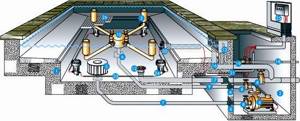
filter for water intake from the fountain bowl 6. Fittings for a sealed passage through the bottom and walls 7. Suction pipeline 8. Control valve 9. Supply pipeline 10. Water flow distributor 12. Bottom drain fittings 13. Built-in topping/overflow system (skimmer) 16. Overflow pipe (built-in) 17. Drain pipe 18. Clean water supply pipe 19. Solenoid valve 20. Sealed cable entry 21. Protective pipe for cable laying 23. Cable protection bus 24. Underwater light 25. Fountain control cabinet 26. Anti-vandal decorative grille
Construction stages
1. Project development
At the design stage, all the characteristics of the fountain are laid down; safety, reliability, durability, external beauty and cost-effectiveness of its operation. The project allows you to clearly understand the volume of necessary earthen and concrete (if concreting is provided) work, a list of main and additional equipment, what and how many materials will be required, to protect against alterations and waste of material, and much more. Competent design optimizes the cost of constructing a fountain.
Designing fountains usually involves several stages
— Development of a design project:
Determining the appearance, choosing a model of fountains and facing materials, operating modes of jets and lighting, as well as linking the fountain to a specific interior/exterior.
Development of a design project involves the following work:
- the style of the fountain is determined - the general concept is determined - the plan is outlined (reference to the terrain) - a decision is made on the cladding material - the height and configuration of the fountain jets are determined - the general color scheme, lighting (above and underwater) are determined - the issue of the need to equip the fountain with a filter is decided automatic topping - attention is fixed on individual complex elements (pots, sculptures, etc.), their detailing - design visualization (sketches, drawings ready to be shown to the customer, electronic version of the design project) Of course, in any design project there are a lot of nuances and features. If these are light and music fountains, then the designers work together with specialists in the relevant field. However, this applies to any fountains: dancing, floating, illuminated, sculptural, so-called “eternal”, etc. Harmony, presence of taste, consonance with the interior/exterior must be present in every fountain, even the most modest. To ensure that a garden fountain fits freely and naturally into the space surrounding it, design elements such as flowering and leafy ornamental plants, shrubs and trees, as well as stones or boulders of unusual shapes, openwork trellises, etc. can be provided. It is only important to remember: the main thing is a sense of proportion and taste, otherwise the fountain may get lost among the decorative elements.
— Development of a construction project: Development of design and engineering schemes, construction drawings, hydraulic and electrical calculations, connection points, methods of laying communications. The water supply and filter system of fountains is planned, technology and waterproofing are selected, etc. At this stage, designers are also studying the weather conditions of the area where it is planned to install the fountain, analyzing the prevailing winds (preventing increased water consumption (due to its being carried away outside the bowl, and, accordingly, the safety and comfort of people)). Not only park fountains, which attract masses of people, but, in fact, all others, should ensure that people can stay in close proximity to them without any problems. It is unlikely that residents of a settlement where strong gusty winds constantly blow will enjoy walking by a fountain that showers them with cold spray. And the pattern formed by the jets is disrupted (especially if it is a “dancing” fountain). Designers are required to provide for these points. In these cases, the fountain device must contain wind speed sensors. They automatically change pump performance depending on indicators. At the design stage, a technological diagram of the fountain, an automation and control system for its operation are also developed, certain construction technologies and other important points are outlined.
2. Arrangement of the pool bowl
The bowl can be of several types:
- a concrete bowl with mandatory waterproofing - a ready-made rigid plastic form dug into the ground - a reservoir built according to the principles of film technology or liquid rubber Builders link together construction and engineering, i.e. they equip and line the bowl, install equipment, and lay communications and utility networks in accordance with GOSTs and sanitary standards and rules.
3. Ensuring the type of water movement
Water can flow slowly, barely noticeably, or it can rush down from a great height with noise and a cascade of splashes. It can bubble with bubbles, like a natural spring, or it can murmur cheerfully in a small ringing stream. The creation of fountains is unthinkable without a driving force - a pump. The simplest construction solution is to install a submersible pump. If, according to the customer’s intention and design, the jet height does not exceed 1.2 meters, they are usually limited to a low-voltage pump (24 V). Large fountains require a submersible pump running on mains power. A more complex option is the so-called “dry” installation of the pump. The connection to the fountain is carried out using a supply and return pipeline. In this case, you will get a more expensive fountain, its price increases due to the installation of a special pumping chamber, which should be equipped below the level of the bottom of the reservoir, and the purchase of a large number of pipes. However, this option can be considered vandal-proof, and servicing a fountain with a “dry” pump will be cheaper.
4. Commissioning work
Specialists check and regulate all systems and equipment operating modes.
5. Decoration of the fountain
At this stage, all technical components and communications are skillfully hidden, the structure is refined, and its finished appearance is given. Today, fountains made of stone, natural or artificial, are very popular. The combination of water and stone has always been considered beautiful and natural. Such fountains are an excellent decoration for a city park, country or garden plot, as well as an office or shopping center. It is unnecessary to remind that the construction of a stone fountain should be carried out by people who are qualified in the field of stone processing and knowledge of its features and properties.
Equipment for fountains
The most necessary equipment for fountains is a pump and a nozzle, and everything else is elements designed to either decorate or facilitate the management and maintenance of the fountain. Meanwhile, observing a modest drinking fountain, and then a grandiose fountain ensemble, the jets of which soar tens of meters at a speed of 200 km/h, about the latter you will doubt - is it only a pump and nozzles that it needs?.. The equipment depends on the size, type, type and purpose of the fountain . Pumps: Pumps are submersible and dry. Which fountain pump you need depends on the planned performance, power and other characteristics. There are energy-saving pumps that contain wear-resistant ceramic parts. Nozzles: Fountain nozzles form the water flow and determine the configuration of the water picture, i.e. They give the jets the shape that is laid down at the design stage. This may be a sudden ejection of water under strong pressure, or it may be a slight dispersion. Water can easily flow out of the nozzle, or it can splash cheerfully in the shape of a hemisphere, funnel, etc. A colossal number of attachments creates a variety of types of water paintings. Modern nozzles are made of steel, copper or plastic. Some of them are immersed in water, others are left visible above the water, others are covered with stones or pebbles in order to create the effect of a natural spring.
External or underwater lighting of fountains:
It could be just one lamp, or it could be a whole system. Even during the development of the project, it is necessary to provide for the selection of colors, the place from which the fountain should be illuminated, or which part of it should be illuminated, etc. An important point in lighting is electrics; it must be handled by a specialist, and then the lighting system will serve for a long time and safely. If dynamic light fountains are installed, the lighting should be in optimal harmony with the movement of the jets. It is necessary to build a chain of parallel operation of light and water. Today, traditional lamps are being replaced by fiberglass light guides, which have the ability to dynamically and color distribute light in fountain jets. A floating fountain that moves freely across a body of water:
Such a fountain requires reinforced equipment. A giant fountain of this type, which has no equal in the whole world, is located on the Neva near Vasilyevsky Island (the equipment and work were carried out by specialists). The design contains musical equipment and multi-color lighting, and special rotating devices create a variety of water patterns. 695 pumps, laser and video installations and over 2,600 lamps were installed on the pontoon field. When the full mode is turned on, the fountain jets form a continuous water screen, onto which a light image is projected using lasers and spotlights, accompanied by suitable music. In addition to the equipment listed, fountains are equipped with water level control sensors and wind speed sensors, sand filters, chemical metering devices, etc. Fountain construction technology
The construction principles of fountain technology are determined by its purpose - to set water in motion. To set water in motion and create a beautiful, attractive water picture, first of all, you need to have a sufficient amount of water. If there is no natural source, for example, a pond or lake, then they should be created and replenished with water from the main water supply. Artificial reservoirs, as a rule, are made in the ground and are waterproofed with molding clay, bitumen or polyvinyl chloride film. Fountain bowls are most often constructed of concrete, but they can also be made of plastic or stainless steel. Once the issue of a water reservoir has been resolved, the need arises to find a way to move the water and choose the right type of water structure. The movement of water can be barely noticeable - in the form of a current in a pond, a running stream, bubbling bubbles of a spring, or in the form of a multi-cascade fountain, a transparent water bell, a powerful fountain or a cascading waterfall. When the water pattern has been determined and, accordingly, a nozzle or combination of nozzles has been selected, it is necessary to select the “driving force” - the fountain pump. The simplest solution would be to install a submersible pump in the pool. A slightly more expensive and difficult to install option is to “dry” install a centrifugal pump outside the pool. Such a pump is usually installed below the bottom of the pool in a pump chamber or basement and is connected to the fountain through supply and return pipelines. A fountain structure requires three main elements: a water reservoir, a fountain head and a pump. All other structural elements of the fountain structure serve to decorate the fountain, as well as to simplify management and maintenance.
Like
Comments
0 FOUNTAIN - Masha Kyprianova 02/03/2015 16:29 WOW! This is Wonderful Information, very Beautiful!
Reply | Reply with quote | Quote | Report to moderator
Update list of comments RSS feed of comments for this entry
Add a comment
Only registered users can leave comments. Swearing, flooding, insults of other users, and unreasoned statements are prohibited. Links to other sites and advertising, only with the permission of the administrator or employee of the company.
JComments

